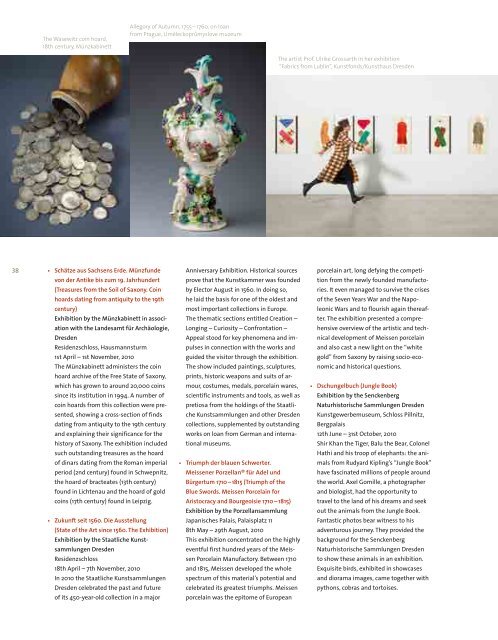Annual Report 2010 - Staatliche Kunstsammlungen Dresden
Annual Report 2010 - Staatliche Kunstsammlungen Dresden
Annual Report 2010 - Staatliche Kunstsammlungen Dresden
You also want an ePaper? Increase the reach of your titles
YUMPU automatically turns print PDFs into web optimized ePapers that Google loves.
38<br />
The Wasewitz coin hoard,<br />
18th century, Münzkabinett<br />
• Schätze aus Sachsens Erde. Münzfunde<br />
von der Antike bis zum 19. Jahrhundert<br />
(Treasures from the Soil of Saxony. Coin<br />
hoards dating from antiquity to the 19th<br />
century)<br />
Exhibition by the Münzkabinett in association<br />
with the Landesamt für Archäologie,<br />
<strong>Dresden</strong><br />
Residenzschloss, Hausmannsturm<br />
1st April – 1st November, <strong>2010</strong><br />
The Münzkabinett administers the coin<br />
hoard archive of the Free State of Saxony,<br />
which has grown to around 20,000 coins<br />
since its institution in 1994. A number of<br />
coin hoards from this collection were presented,<br />
showing a crosssection of finds<br />
dating from antiquity to the 19th century<br />
and explaining their significance for the<br />
history of Saxony. The exhibition included<br />
such outstanding treasures as the hoard<br />
of dinars dating from the Roman imperial<br />
period (2nd century) found in Schwepnitz,<br />
the hoard of bracteates (13th century)<br />
found in Lichtenau and the hoard of gold<br />
coins (17th century) found in Leipzig.<br />
• Zukunft seit 1560. Die Ausstellung<br />
(State of the Art since 1560. The Exhibition)<br />
Exhibition by the <strong>Staatliche</strong> <strong>Kunstsammlungen</strong><br />
<strong>Dresden</strong><br />
Residenzschloss<br />
18th April – 7th November, <strong>2010</strong><br />
In <strong>2010</strong> the <strong>Staatliche</strong> <strong>Kunstsammlungen</strong><br />
<strong>Dresden</strong> celebrated the past and future<br />
of its 450yearold collection in a major<br />
allegory of autumn, 1755 – 1760, on loan<br />
from Prague, Uměleckoprůmyslove muzeum<br />
Anniversary Exhibition. Historical sources<br />
prove that the Kunstkammer was founded<br />
by Elector August in 1560. In doing so,<br />
he laid the basis for one of the oldest and<br />
most important collections in Europe.<br />
The thematic sections entitled Creation –<br />
Longing – Curiosity – Confrontation –<br />
Appeal stood for key phenomena and impulses<br />
in connection with the works and<br />
guided the visitor through the exhibition.<br />
The show included paintings, sculptures,<br />
prints, historic weapons and suits of armour,<br />
costumes, medals, porcelain wares,<br />
scientific instruments and tools, as well as<br />
pretiosa from the holdings of the <strong>Staatliche</strong><br />
<strong>Kunstsammlungen</strong> and other <strong>Dresden</strong><br />
collections, supplemented by outstanding<br />
works on loan from German and international<br />
museums.<br />
• Triumph der blauen Schwerter.<br />
Meissener Porzellan® für Adel und<br />
Bürgertum 1710 – 1815 (Triumph of the<br />
Blue Swords. Meissen Porcelain for<br />
Aristocracy and Bourgeoisie 1710 – 1815)<br />
Exhibition by the Porzellansammlung<br />
Japanisches Palais, Palaisplatz 11<br />
8th May – 29th August, <strong>2010</strong><br />
This exhibition concentrated on the highly<br />
eventful first hundred years of the Meissen<br />
Porcelain Manufactory. Between 1710<br />
and 1815, Meissen developed the whole<br />
spectrum of this material’s potential and<br />
celebrated its greatest triumphs. Meissen<br />
porcelain was the epitome of European<br />
The artist Prof. Ulrike Grossarth in her exhibition<br />
“Fabrics from Lublin”, Kunstfonds/Kunsthaus <strong>Dresden</strong><br />
porcelain art, long defying the competition<br />
from the newly founded manufactories.<br />
It even managed to survive the crises<br />
of the Seven Years War and the Napoleonic<br />
Wars and to flourish again thereafter.<br />
The exhibition presented a comprehensive<br />
overview of the artistic and technical<br />
development of Meissen porcelain<br />
and also cast a new light on the “white<br />
gold” from Saxony by raising socioeconomic<br />
and historical questions.<br />
• Dschungelbuch (Jungle Book)<br />
Exhibition by the Senckenberg<br />
Naturhistorische Sammlungen <strong>Dresden</strong><br />
Kunstgewerbemuseum, Schloss Pillnitz,<br />
Bergpalais<br />
12th June – 31st October, <strong>2010</strong><br />
Shir Khan the Tiger, Balu the Bear, Colonel<br />
Hathi and his troop of elephants: the animals<br />
from Rudyard Kipling’s “Jungle Book”<br />
have fascinated millions of people around<br />
the world. Axel Gomille, a photographer<br />
and biologist, had the opportunity to<br />
travel to the land of his dreams and seek<br />
out the animals from the Jungle Book.<br />
Fantastic photos bear witness to his<br />
adventurous journey. They provided the<br />
background for the Senckenberg<br />
Naturhistorische Sammlungen <strong>Dresden</strong><br />
to show these animals in an exhibition.<br />
Exquisite birds, exhibited in showcases<br />
and diorama images, came together with<br />
pythons, cobras and tortoises.

















